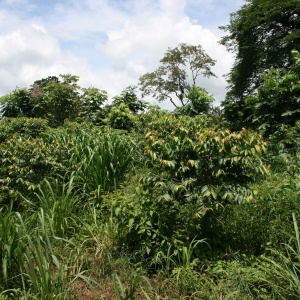
In this article a group of American researchers provide commentary on how sustainable applications of integrated agricultural systems (IAS) can be designed to enhance all ecosystem services, without compromising the land’s resilience. The authors describe IAS as an interactive and synergistic resource transfer between multiple agricultural enterprises over space and/or time.
They point out that innovative agricultural management can help match land use with land potential, and that this flexibility in management allows for sustainable land-use over time. The authors say that the challenge of aligning agricultural management with land potential for sustainable production is more possible now than it ever has been – a result of the land evaluation methods available and advances in “locally adapted agricultural practices”.
The researchers illustrate how socioeconomic factors serve as “translation filters” between land potential and land use using the figure below, explaining that: “ecosystem service outcomes from land-use decisions can recalibrate the filters through feedbacks in a variety of ways (e.g., community health, economic vitality, landscape aesthetics, etc.), thereby providing a means for continual improvement of agricultural landscapes through market influences, public policy, and ultimately, producers’ decisions”.
The principles of integrated agricultural systems are not described in this article, but it does refer to a paper that provides an introduction to the processes (and definition) of IAS that you can access here (link is external, open access).
While stating that there is potential for IAS to deliver all ecosystem services sustainably, the researchers point out the need to research and share best land use practices for lands of varying potential – enabling the development of locally adapted frameworks and “best-suited” agricultural enterprises.
Abstract
Contemporary agricultural land use is dominated by an emphasis on provisioning services by applying energy-intensive inputs through relatively uniform production systems across variable landscapes. This approach to agricultural land use is not sustainable. Achieving sustainable use of agricultural land should instead focus on the application of innovative management systems that provide multiple ecosystem services on lands with varying inherent qualities. Integrated agricultural systems (IAS) represent an alternative approach to prevailing land use, whereby site-adapted enterprises are implemented to enhance synergistic resource transfer among enterprises and sustainable delivery of ecosystem services. Sustainable deployment of IAS on agricultural land involves placing the “right enterprise” at the “right intensity” at the “right time” on the “right location,” with the inherent attributes of location providing guidance for management decisions. There is an urgent need to design IAS that enhance delivery of ecosystem services while ensuring land potential thresholds are not exceeded.
Reference
Liebig, M.A., Herrick, J.E., Archer, D.W., Dobrowolski, J., Duiker, S.W., Franzluebbers, A.J., Hendrickson, J.R., Mitchell, R., Mohamed, A., Russell, J. and Strickland, T.C., 2017. Aligning Land Use with Land Potential: The Role of Integrated Agriculture. Agricultural & Environmental Letters, 2(1).
You can read the full article here (open access).







Post a new comment »